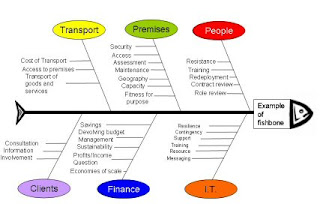11. Project Risk Management
Do project managers understand what risk is and the importance of good project risk management? Risk management is often overlooked in projects, but it can help improve project success by helping select good projects, determining project scope, and developing realistic estimates. There exists mainly two types of risks. Positive and negative risks. Negative risk involves understanding potential problems that might occur in the project and how they might impede project success. Negative risk management is like a form of insurance; it is an investment. Beside this, positive risks are risks that result in good things happening; sometimes called opportunities.
the importance of good project risk management? Risk management is often overlooked in projects, but it can help improve project success by helping select good projects, determining project scope, and developing realistic estimates. There exists mainly two types of risks. Positive and negative risks. Negative risk involves understanding potential problems that might occur in the project and how they might impede project success. Negative risk management is like a form of insurance; it is an investment. Beside this, positive risks are risks that result in good things happening; sometimes called opportunities.
Project Risk Management Processes:
1 - Risk Management Planning: deciding how to approach and plan the risk management activities for the project. The main output of risk management planning is a risk management plan —a plan that documents the procedures for managing risk throughout a project.The project team should review project documents and understand the organization’s and the sponsor’s approaches to risk. This is because of different reasons, one of which is that sponsors acceptance of risk depends from one sponsor to another.
Good practice of risks management includes the contingency plans which are predefined actions that the project team will take if an identified risk event occurs. Moreover, an organization may reserve contingency reserves or allowances which are provisions held by the project sponsor or organization to reduce the risk of cost or schedule overruns to an acceptable level. For ease of understanding and managing we define risks as: - Market risk
- Financial risk
- Technology risk
- People risk
- Structure/process risk
Risk Identification is the process of determining which risks are likely to affect a project and documenting the characteristics of each. It also helps in understanding what potential events might hurt or enhance a particular project
Risk identification tools and techniques include: Brainstorming / The Delphi / Technique / Interviewing and SWOT analysis. We assume that you are familiar with the above techniques therefore we are not going into details. Just as a reminder, SWOT analysis stands for: strengths, weaknesses, opportunities, and threats). In this case, it helps identify the broad negative and positive risks that apply to a project. One more document that is used in this step is the risk register. I will add a sample of risk register that I did in an assignment in the links of other works. A risk register is a document that contains the results of various risk management processes and that is often displayed in a table or spreadsheet format.
Qualitative Risk Analysis is the process of prioritizing risks based on their probability and impact of occurrence. Risk quantification tools and techniques include: a) Probability/impact matrixes, b)The Top Ten Risk Item Tracking and c)
Expert judgment. Just for illustration i am showing the sample of probability/impact matrix:
Quantitative Risk Analysis: is the process of numerically estimating the effects of risks on project objectives. In different from qualitative which is more concerned with quality or impact of risk in a qualitative form. This often come after qualitative risk analysis, but sometimes both can be done together for a better analysis. Main techniques include: a) Decision tree analysis and b) Simulation
Sensitivity analysis. (Sensitivity analysis is a technique used to show the effects of changing one or more variables on an outcome).
Risk Response Planning: involves taking steps to enhance opportunities and reduce threats to meeting project objectives. After identifying and quantifying risks, you must decide how to respond to them.
Four main response strategies for negative risks:
1) Risk avoidance
2) Risk acceptance
3) Risk transference
4) Risk mitigation
And the last process on project risk management is:
Risk Monitoring and Control: which is concerned about monitoring identified and residual risks, identifying new risks, carrying out risk response plans, and evaluating the effectiveness of risk strategies throughout the life of the project.
It involves executing the risk management process to respond to risk events.
Main outputs of risk monitoring and control are: a) Requested changes b) Recommended corrective and preventive actions c) Updates to the risk register, project management plan, and organizational process assets.
In conclusion we may say that well-run projects appear to be almost effortless, but a lot of work goes into running a project well. Project managers should strive to make their jobs look easy to reflect the results of well-run projects.
 the importance of good project risk management? Risk management is often overlooked in projects, but it can help improve project success by helping select good projects, determining project scope, and developing realistic estimates. There exists mainly two types of risks. Positive and negative risks. Negative risk involves understanding potential problems that might occur in the project and how they might impede project success. Negative risk management is like a form of insurance; it is an investment. Beside this, positive risks are risks that result in good things happening; sometimes called opportunities.
the importance of good project risk management? Risk management is often overlooked in projects, but it can help improve project success by helping select good projects, determining project scope, and developing realistic estimates. There exists mainly two types of risks. Positive and negative risks. Negative risk involves understanding potential problems that might occur in the project and how they might impede project success. Negative risk management is like a form of insurance; it is an investment. Beside this, positive risks are risks that result in good things happening; sometimes called opportunities.Project Risk Management Processes:
1 - Risk Management Planning: deciding how to approach and plan the risk management activities for the project. The main output of risk management planning is a risk management plan —a plan that documents the procedures for managing risk throughout a project.The project team should review project documents and understand the organization’s and the sponsor’s approaches to risk. This is because of different reasons, one of which is that sponsors acceptance of risk depends from one sponsor to another.
Good practice of risks management includes the contingency plans which are predefined actions that the project team will take if an identified risk event occurs. Moreover, an organization may reserve contingency reserves or allowances which are provisions held by the project sponsor or organization to reduce the risk of cost or schedule overruns to an acceptable level. For ease of understanding and managing we define risks as: - Market risk
- Financial risk
- Technology risk
- People risk
- Structure/process risk
Risk Identification is the process of determining which risks are likely to affect a project and documenting the characteristics of each. It also helps in understanding what potential events might hurt or enhance a particular project
Risk identification tools and techniques include: Brainstorming / The Delphi / Technique / Interviewing and SWOT analysis. We assume that you are familiar with the above techniques therefore we are not going into details. Just as a reminder, SWOT analysis stands for: strengths, weaknesses, opportunities, and threats). In this case, it helps identify the broad negative and positive risks that apply to a project. One more document that is used in this step is the risk register. I will add a sample of risk register that I did in an assignment in the links of other works. A risk register is a document that contains the results of various risk management processes and that is often displayed in a table or spreadsheet format.
Qualitative Risk Analysis is the process of prioritizing risks based on their probability and impact of occurrence. Risk quantification tools and techniques include: a) Probability/impact matrixes, b)The Top Ten Risk Item Tracking and c)
Expert judgment. Just for illustration i am showing the sample of probability/impact matrix:

Quantitative Risk Analysis: is the process of numerically estimating the effects of risks on project objectives. In different from qualitative which is more concerned with quality or impact of risk in a qualitative form. This often come after qualitative risk analysis, but sometimes both can be done together for a better analysis. Main techniques include: a) Decision tree analysis and b) Simulation
Sensitivity analysis. (Sensitivity analysis is a technique used to show the effects of changing one or more variables on an outcome).
Risk Response Planning: involves taking steps to enhance opportunities and reduce threats to meeting project objectives. After identifying and quantifying risks, you must decide how to respond to them.
Four main response strategies for negative risks:
1) Risk avoidance
2) Risk acceptance
3) Risk transference
4) Risk mitigation
And the last process on project risk management is:
Risk Monitoring and Control: which is concerned about monitoring identified and residual risks, identifying new risks, carrying out risk response plans, and evaluating the effectiveness of risk strategies throughout the life of the project.
It involves executing the risk management process to respond to risk events.
Main outputs of risk monitoring and control are: a) Requested changes b) Recommended corrective and preventive actions c) Updates to the risk register, project management plan, and organizational process assets.
In conclusion we may say that well-run projects appear to be almost effortless, but a lot of work goes into running a project well. Project managers should strive to make their jobs look easy to reflect the results of well-run projects.


Comments